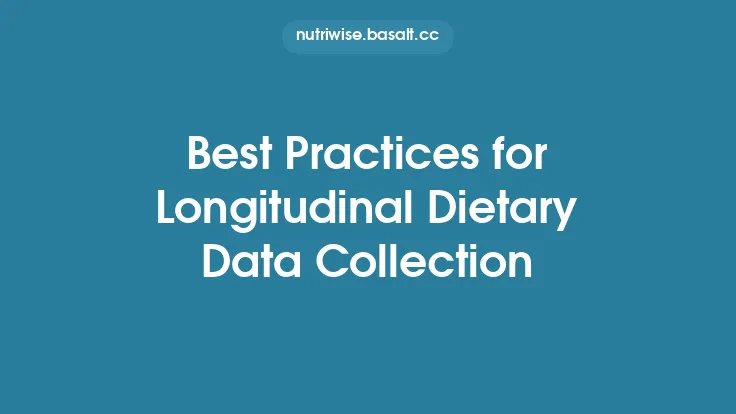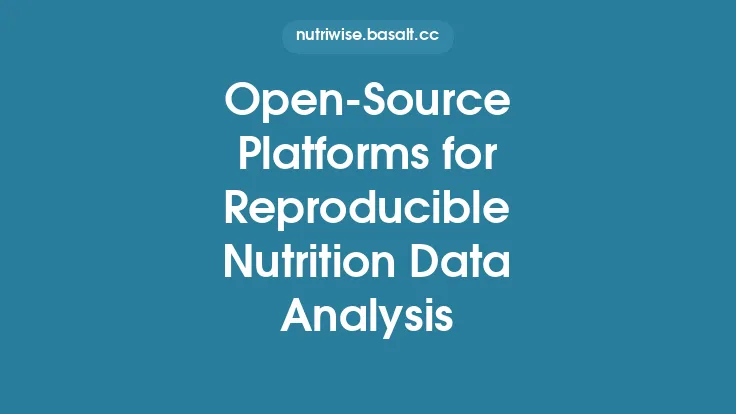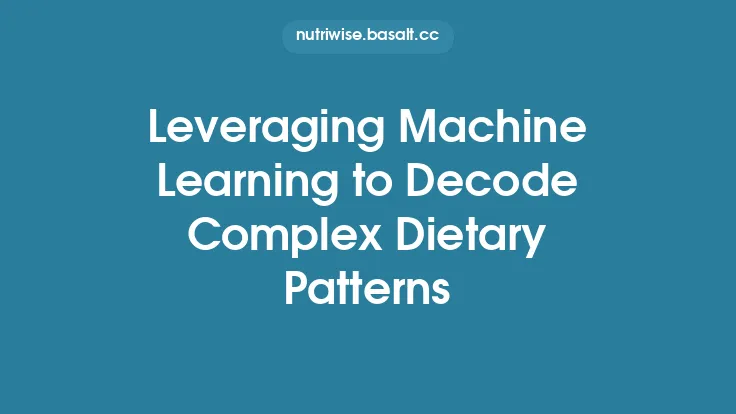Missing data are an inevitable challenge in nutrition research. Whether the gap arises from incomplete 24‑hour recalls, skipped items on food frequency questionnaires, or lost dietary records, the presence of missing observations can bias estimates of nutrient intake, attenuate associations with health outcomes, and reduce statistical power. Over the past decade, a suite of statistical methods has been developed and refined specifically to address these issues while preserving the complex, multivariate nature of dietary data. This article surveys the most influential and emerging techniques, outlines their underlying assumptions, and provides practical guidance for their application in contemporary nutrition studies.
Understanding Missing Data in Nutrition Research
Missing data mechanisms
The first step in any analysis of incomplete dietary data is to characterize the mechanism that generated the missingness. Rubin’s taxonomy remains the cornerstone:
| Mechanism | Definition | Implications for analysis |
|---|---|---|
| Missing Completely at Random (MCAR) | The probability of missingness is unrelated to any observed or unobserved variable. | Simple methods (e.g., complete‑case analysis) remain unbiased but are inefficient. |
| Missing at Random (MAR) | Missingness may depend on observed variables (e.g., age, BMI, socioeconomic status) but not on the unobserved dietary values themselves. | Methods that condition on observed covariates (e.g., multiple imputation, full information maximum likelihood) can produce unbiased estimates. |
| Missing Not at Random (MNAR) | Missingness depends on the unobserved dietary values (e.g., participants under‑report high-fat foods). | Requires explicit modeling of the missingness process (pattern‑mixture or selection models) and sensitivity analyses. |
In nutrition research, MAR is often a reasonable approximation when missingness correlates with demographic or health variables that are recorded. However, systematic under‑reporting of certain foods suggests that MNAR mechanisms are also common, motivating the use of more sophisticated approaches.
Structure of dietary data
Dietary data are inherently high‑dimensional and compositional:
- Multivariate: A single respondent provides intakes for dozens of foods and nutrients.
- Zero‑inflated: Many foods are not consumed on a given day, leading to excess zeros.
- Correlated: Foods are consumed in patterns (e.g., fruit with yogurt) that induce strong inter‑item correlations.
- Bounded: Energy and nutrient intakes have physiological lower and upper limits.
Statistical methods must respect these features to avoid implausible imputations (e.g., negative nutrient values) and to preserve the underlying dietary structure.
Classical Approaches to Missing Data
Complete‑case analysis (CCA)
The simplest approach discards any participant with missing dietary information. While unbiased under MCAR, CCA can dramatically reduce sample size and power, especially in large surveys where missingness is common.
Available‑case (pairwise) analysis
Uses all available data for each pairwise correlation or regression. This method retains more data than CCA but can produce inconsistent covariance matrices, complicating multivariate modeling.
Mean or median substitution
Replacing missing values with the overall mean or median of the variable is easy to implement but inflates variance underestimation and biases regression coefficients, particularly when missingness is related to covariates.
These classical techniques are largely discouraged in modern nutrition research, serving mainly as historical benchmarks rather than recommended practices.
Multiple Imputation (MI) Techniques
Multiple imputation has become the workhorse for handling MAR missingness in dietary studies. The process involves three steps: (1) generating *m* plausible complete datasets, (2) analyzing each dataset separately, and (3) pooling results using Rubin’s rules.
1. Fully Conditional Specification (FCS) / Chained Equations
- Concept: Impute each variable conditionally on all others using appropriate regression models (e.g., linear for continuous nutrients, logistic for binary food‑presence indicators).
- Strengths: Flexibility to accommodate mixed data types and complex relationships; widely implemented in software such as `mice` (R) and `PROC MI` (SAS).
- Considerations: Requires careful ordering of variables and convergence diagnostics; may struggle with high dimensionality if the number of foods exceeds the number of participants.
2. Joint Modeling (JM)
- Concept: Specify a multivariate distribution (often multivariate normal) for all variables and draw imputations from the joint posterior.
- Strengths: Guarantees coherence across imputations; easier to incorporate random effects for clustered designs (e.g., school‑based studies).
- Limitations: The normality assumption can be violated by skewed nutrient intakes; extensions such as the multivariate log‑normal or Dirichlet‑multinomial models have been proposed for compositional data.
3. Imputation of Energy‑Adjusted Intakes
Because total energy intake is a strong predictor of individual nutrient intakes, many researchers first impute total energy and then impute nutrient densities conditional on the imputed energy. This two‑stage approach preserves the physiological relationship between energy and nutrients.
4. Incorporating Survey Weights
When analyzing nationally representative surveys (e.g., NHANES), it is essential to incorporate sampling weights into the imputation model. Weighted MI procedures adjust the imputation model to reflect the complex survey design, reducing bias in population‑level estimates.
5. Diagnostics and Model Checking
- Convergence: Trace plots of imputed means across iterations.
- Distributional checks: Compare observed and imputed histograms for each variable.
- Predictive mean matching (PMM): Helps preserve the original data distribution, especially for skewed nutrients.
Bayesian Hierarchical Models for Missing Dietary Data
Bayesian frameworks naturally accommodate uncertainty about missing values by treating them as latent parameters with prior distributions. Recent advances have tailored hierarchical models to the idiosyncrasies of dietary data.
1. Dirichlet‑Multinomial Models
- Application: Modeling the composition of food groups within a total energy budget.
- Missingness handling: Unobserved food counts are integrated out via the Dirichlet prior, yielding posterior predictive distributions that respect compositional constraints (i.e., sums to total energy).
2. Latent Variable Factor Models
- Concept: Introduce latent dietary patterns (factors) that explain correlations among foods. Missing food intakes are inferred from the posterior distribution of the latent factors.
- Benefit: Simultaneously reduces dimensionality and imputes missing values, preserving underlying dietary patterns.
3. Gaussian Process (GP) Priors for Temporal Data
For longitudinal dietary records (e.g., repeated 24‑hour recalls), GP priors capture smooth trajectories over time. Missing days are imputed by borrowing strength from adjacent observations, while accounting for within‑person correlation.
4. Computational Tools
- Stan: Allows specification of complex hierarchical models with efficient Hamiltonian Monte Carlo sampling.
- JAGS/BUGS: Traditional Gibbs sampling engines, still useful for simpler models.
Bayesian methods excel when prior information (e.g., typical nutrient distributions) is available, or when the missingness mechanism is suspected to be MNAR and can be encoded via informative priors.
Pattern‑Mixture and Selection Models for MNAR Data
When missingness depends on unobserved dietary values, standard MI under MAR may be insufficient. Two families of models explicitly address MNAR mechanisms.
1. Pattern‑Mixture Models (PMM)
- Structure: Partition the data into missingness patterns (e.g., “complete”, “missing fruit intake”, “missing total energy”) and model the distribution of observed variables within each pattern.
- Implementation: Often combined with MI by specifying different imputation models for each pattern, then applying a *delta‑adjustment* to shift imputed values according to hypothesized MNAR mechanisms.
- Sensitivity analysis: Vary the delta parameter to assess how conclusions change under different MNAR assumptions.
2. Selection Models
- Structure: Jointly model the outcome (e.g., nutrient intake) and the missingness indicator, typically via a logistic regression for the missingness probability that includes the (possibly unobserved) dietary variable.
- Estimation: Requires integration over the distribution of the missing variable; Bayesian estimation or maximum likelihood via the Expectation–Maximization (EM) algorithm are common.
- Application: Useful when there is substantive knowledge that under‑reporting is linked to high intake of specific foods (e.g., sugary beverages).
Both PMM and selection models are computationally intensive and rely on unverifiable assumptions; therefore, they are most valuable as part of a broader sensitivity‑analysis framework.
Inverse Probability Weighting (IPW) and Full Information Maximum Likelihood (FIML)
Inverse Probability Weighting
- Idea: Assign each observed case a weight equal to the inverse of its probability of being observed, estimated from a model of missingness (often logistic regression on observed covariates).
- Strengths: Provides unbiased estimates under MAR without imputing missing values; compatible with complex survey designs.
- Challenges: Extreme weights can increase variance; stabilization techniques (e.g., truncation) are recommended.
Full Information Maximum Likelihood
- Concept: Directly maximizes the likelihood of all observed data, integrating over missing components under the assumed multivariate distribution.
- Implementation: Available in structural equation modeling (SEM) packages such as `lavaan` (R) and `Mplus`.
- Advantages: Efficient use of all available information; naturally handles MAR.
- Limitations: Requires correct specification of the joint distribution; may be less flexible for zero‑inflated or compositional data.
Both IPW and FIML are attractive alternatives to MI when the analyst prefers a single‑step estimation approach.
Machine‑Learning–Based Imputation Methods
While the article “Leveraging Machine Learning to Decode Complex Dietary Patterns” focuses on pattern discovery, machine‑learning algorithms are also powerful tools for imputing missing dietary values. Their use is growing in nutrition research, provided they are applied with caution.
1. Random Forest Imputation (missForest)
- Mechanism: Iteratively fits random forests to predict each variable with missing values using all other variables as predictors.
- Pros: Handles mixed data types, captures nonlinear relationships, and is robust to outliers.
- Cons: Computationally demanding for very high‑dimensional food‑frequency data; may overfit if the number of trees is not tuned.
2. Gradient Boosting Machines (e.g., XGBoost)
- Application: Similar to random forests but often yields higher predictive accuracy with proper regularization.
- Considerations: Requires careful cross‑validation to avoid optimistic imputations; interpretability can be limited.
3. Autoencoders (Neural Networks)
- Structure: An unsupervised neural network learns a low‑dimensional representation of the dietary data; missing entries are reconstructed from the latent code.
- Strengths: Excellent for high‑dimensional, sparse data; can incorporate side information (e.g., demographic covariates) as auxiliary inputs.
- Weaknesses: Requires large sample sizes for stable training; hyperparameter tuning is nontrivial.
4. K‑Nearest Neighbors (KNN) Imputation
- Simple approach: Impute a missing value with the average of the *k* most similar respondents based on observed variables.
- Utility: Useful as a baseline; however, performance deteriorates with many missing entries.
When employing machine‑learning imputations, it is essential to:
- Preserve distributional properties (e.g., avoid negative nutrient values).
- Validate imputations using hold‑out data or simulation studies.
- Combine with MI: Some researchers generate multiple imputations using a machine‑learning predictor within each iteration, merging the flexibility of ML with the inferential framework of MI.
Sensitivity Analyses and Diagnostics
Given that any missing‑data method rests on untestable assumptions, rigorous sensitivity analysis is a cornerstone of credible nutrition research.
- Delta‑adjustment MI: Add a constant (δ) to imputed values for variables suspected of MNAR, then examine how effect estimates shift.
- Pattern‑specific analyses: Compare results across sub‑samples defined by missingness patterns (e.g., participants with complete 24‑hour recalls vs. those missing a snack item).
- Weight trimming: In IPW, assess the impact of truncating extreme weights at various percentiles.
- Posterior predictive checks: For Bayesian models, simulate replicated datasets and compare summary statistics (e.g., mean nutrient intake) to the observed data.
Reporting the range of plausible results across these scenarios enhances transparency and informs readers about the robustness of conclusions.
Practical Implementation and Software Tools
| Method | Primary R Packages | SAS / Stata | Python |
|---|---|---|---|
| Multiple Imputation (FCS) | `mice`, `amelia`, `norm` | `PROC MI` | `statsmodels.imputation.mice` |
| Joint Modeling MI | `pan`, `mi` | `PROC MI` (JM option) | `pyMI` (experimental) |
| Bayesian Hierarchical Imputation | `rstan`, `brms`, `nimble` | `PROC MCMC` | `PyMC`, `TensorFlow Probability` |
| Pattern‑Mixture Models | `smcfcs`, `pan` (with delta) | Custom macros | `pymc3` (custom) |
| IPW | `survey`, `ipw` | `PROC SURVEYREG` with weights | `statsmodels` |
| FIML (SEM) | `lavaan`, `OpenMx` | `PROC CALIS` | `semopy` |
| Machine‑Learning Imputation | `missForest`, `xgboost`, `keras` (autoencoders) | `PROC HPFOREST` | `scikit‑learn`, `tensorflow` |
Workflow recommendations
- Exploratory data analysis – quantify missingness patterns, assess MCAR via Little’s test, and visualize missingness matrices.
- Model selection – choose MAR‑compatible methods (MI, FIML) as the default; plan MNAR sensitivity analyses.
- Imputation – generate at least 20 imputations for high‑dimensional dietary data; use predictive mean matching for skewed nutrients.
- Model fitting – fit the substantive nutrition model (e.g., diet–disease association) within each imputed dataset.
- Pooling – apply Rubin’s rules; report between‑imputation variance.
- Diagnostics – conduct convergence checks, distributional comparisons, and sensitivity analyses.
- Documentation – provide a reproducible script (e.g., R Markdown) and a summary table of missingness and imputation diagnostics.
Recommendations for Researchers
- Treat missingness as a research question – explicitly state the assumed mechanism (MCAR, MAR, MNAR) and justify it with auxiliary data.
- Leverage auxiliary variables – demographic, anthropometric, and health variables improve the plausibility of MAR and increase imputation efficiency.
- Preserve compositional integrity – when imputing food groups, enforce that the sum of components equals total energy or total servings.
- Avoid single‑imputation shortcuts – single imputation (e.g., mean substitution) underestimates variability and can lead to overconfident inference.
- Report transparently – include the proportion of missing data, the imputation model specification, the number of imputations, and results of sensitivity analyses.
- Plan for computational resources – high‑dimensional MI or Bayesian models can be demanding; consider parallel processing or cloud computing for large surveys.
- Stay current with methodological literature – emerging techniques such as Bayesian non‑parametric models (e.g., Dirichlet process mixtures) are beginning to appear in nutrition journals and may offer superior flexibility for complex dietary data.
Future Directions and Emerging Trends
- Hybrid Bayesian‑MI frameworks: Combining the principled uncertainty quantification of Bayesian models with the practical convenience of MI (e.g., Bayesian MI via `brms`).
- Non‑parametric imputation: Methods like random forests and deep generative models (Variational Autoencoders, Generative Adversarial Networks) that learn the joint distribution without strict parametric assumptions.
- Integration with causal inference: Embedding missing‑data models within causal frameworks (e.g., marginal structural models) to obtain unbiased diet‑outcome effect estimates.
- Dynamic imputation for longitudinal studies: State‑space models and Gaussian processes that simultaneously model time trends and missingness.
- Open‑source reproducibility pipelines: Containerized workflows (Docker, Singularity) that encapsulate the entire imputation‑analysis process, facilitating peer verification.
These advances promise to make handling missing dietary data more robust, efficient, and transparent, ultimately strengthening the evidence base for nutrition policy and practice.
Concluding Remarks
Missing dietary data no longer need to be a barrier to rigorous nutrition research. By understanding the underlying missingness mechanisms, selecting appropriate statistical methods—ranging from multiple imputation and Bayesian hierarchical models to pattern‑mixture and machine‑learning approaches—and conducting thorough sensitivity analyses, researchers can obtain unbiased, efficient estimates of nutrient intake and its health effects. The methodological toolbox described here reflects the current state of the art and points toward a future where sophisticated, reproducible missing‑data solutions are standard practice in nutrition science.





